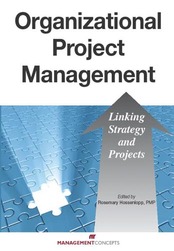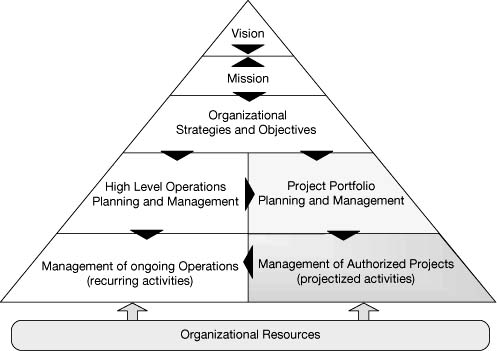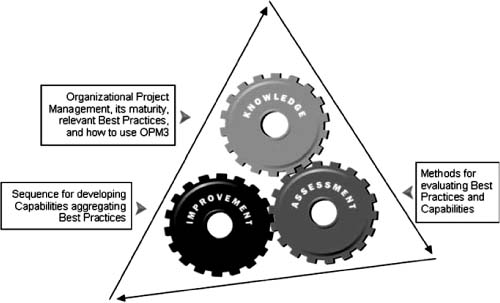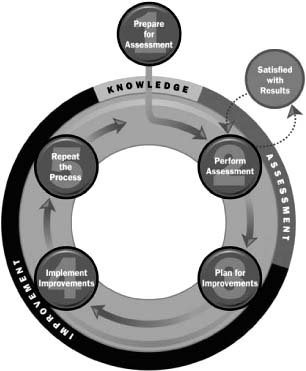
Download PDF Excerpt
Rights Information
Organizational Project Management
Linking Strategy and Projects
Rosemary Hossenlopp (Edited by)
Publication date: 06/01/2010
Organizational project management (OPM) aligns project deliverables with strategy. Understanding this emerging process is essential for all stakeholders, from the corporate sponsor to project team members. OPM is a valuable new tool that can enhance your organization's successful execution of projects in alignment with strategic priorities.
Under the editorship of Rosemary Hossenlopp, PMP, ten contributors from around the globe, representing a wide variety of industries, offer valuable insights on how OPM can give any organization the competitive edge. They discuss how to
• Improve business outcomes
• Better align project work with strategies
• Set priorities
• Organize project work
Whether you direct projects, fund projects, or conduct project work, Organizational Project Management: Linking Strategy and Projects is vital to your understanding of this emerging business discipline.
Find out more about our Bulk Buyer Program
- 10-49: 20% discount
- 50-99: 35% discount
- 100-999: 38% discount
- 1000-1999: 40% discount
- 2000+ Contact ( bookorders@bkpub.com )
Organizational project management (OPM) aligns project deliverables with strategy. Understanding this emerging process is essential for all stakeholders, from the corporate sponsor to project team members. OPM is a valuable new tool that can enhance your organization's successful execution of projects in alignment with strategic priorities.
Under the editorship of Rosemary Hossenlopp, PMP, ten contributors from around the globe, representing a wide variety of industries, offer valuable insights on how OPM can give any organization the competitive edge. They discuss how to
• Improve business outcomes
• Better align project work with strategies
• Set priorities
• Organize project work
Whether you direct projects, fund projects, or conduct project work, Organizational Project Management: Linking Strategy and Projects is vital to your understanding of this emerging business discipline.
CHAPTER 1
OPM: Delivering Business Results from Enterprise Strategy
Russ McDowell, PMP
Are you having trouble getting the results you expect from projects you undertake? Do you struggle to decide which initiatives will deliver the best returns or benefits for your organization? Are you trying to take advantage of new opportunities or implement new initiatives in your company but finding that the implementation never seems to go right? Do you need to improve your organization’s capacity to respond to today’s challenging business environment?
In this chapter, you will discover how you can use organizational project management (OPM) to deliver project results by implementing your enterprise strategies. You will learn:
- How to use proven techniques to implement your organizational strategy—and get tangible results
- How to establish a flexible management approach to capitalize on new opportunities
- About the importance of ensuring each project delivers the business outcomes promised to stakeholders
- Effective ways to ensure the alignment of investments in projects with the strategies of the organization
- How to establish objectivity in the selection and support of projects, based on business criteria.
In today’s fast-paced business environment, a company’s overall approach to OPM will determine whether it is able to address necessary, critical changes identified in executive management’s strategic directions and decisions—and even if the organization will survive.
Most organizations are just in the beginning stages of achieving their strategic objectives through the adoption of project management (PM) best practices. Project managers have their heads down in project work. Executives are buried in bad news. What should we do about this? Start a dialog between project managers and executives on how to deliver benefits, align projects to strategy, and stop wasting time on project work that doesn’t matter.
This is OPM. It is the bridge between an organization’s strategy and operational outcomes. It is about a real conversation that needs to occur—now!
Whatever You Do, Don’t Stand Still!
Today’s organizations face many challenges, including:
- The pressure of globalization and new market opportunities
- The need to increase revenues and decrease costs
- The chaos of mergers and acquisitions
- The relentless cry to increase efficiency
- Pressure to reduce time to market for new products
- Downsizing/rightsizing/outsourcing
- The accelerating pace of technology change
- Legislative changes (e.g., the Sarbanes-Oxley Act; banking and financial reporting regulations).
In addition, the recession that began in 2008 has shown that no company or industry is immune to the current turbulence in the market. Pain is everywhere. The spectacular failures of the housing, banking, and automotive industries have provided all too many examples. If your organization is to prosper, it’s not enough to stand still. You must adapt quickly to a rapidly changing environment.
Projects, by their nature, are the ideal mechanism for implementing the fast-paced, focused changes that are so necessary to today’s business environment. By definition, projects are temporary endeavors, focused on implementing unique solutions while accommodating constraints of resources and scope.
How Can OPM Help?
To understand how OPM can help contribute to the success of your organization, it is first necessary to understand the position that OPM and “projectized activities” play in the day-to-day life of an organization.
First, let’s start with a basic definition. According to the Project Management Institute, OPM “is the systematic management of projects, programs, and portfolios in alignment with the organization’s strategic business goals.”1 Much of the focus and literature in the field of project management has been on how to ensure that projects are done right. However, the real promise of OPM is not in the proper execution of authorized projects, although this is an important facet. The key to being successful in OPM is to ensure a tight relationship between strategic goals and the implementation of new capabilities.
The Organizational Pyramid
To appreciate what OPM can do for your business, it is important to understand the environment within which it exists. Figure 1-1 illustrates four key components of OPM.
- At the top of the pyramid are the areas traditionally covered by an organization’s executive management. This level of management is responsible for the corporate vision—articulating the mission and determining the strategy and objectives that will best attain the vision and mission.
- Below the top level of the pyramid, two approaches that must be balanced for the organization to be successful are shown. On the left side of the pyramid’s base is the operations management of the organization: the day-to-day running of the business, the “keeping the lights on.” The focus here is on implementing ongoing, repetitive functions. To compete, organizations tend to optimize for the operation of routine tasks. Thus, the tendency is for this side of the organization to focus on driving the efficiencies of current operations and incrementally improving current functions.
- On the right side of the pyramid are the projectized activities—areas related to project management—including portfolio and program management. Projectized approaches are generally aimed at implementing significant change within an organization.
- The arrows at the bottom of the pyramid, pointing to both recurring operations and projectized activities, indicate that the organization must be supported by a balanced approach to the use of its resources.

Figure 1-1 The Organizational Context of Portfolio Management
Project Management Institute, The Standard for Portfolio Management, Second Edition, Project Management Institute, Inc. (2008). Copyright and all rights reserved. Material from this publication has been reproduced with the permission of PMI.
The right side of the triangle has been the focus of most of the project management literature. Much has been said, and these multiple voices can help project participants improve the management of projectized activities.
Although PM is important to OPM, it is not our current focus. What no one is talking about is the interfaces and boundaries of operations with the projectized activities. What must happen? Senior management needs more help to optimize the allocation of resources between the operations and the projects. Both aspects require organizational resources (e.g., people, funds, facilities) to perform their roles. Tough decisions are made during high-level operations planning that result in new projects (e.g., setup of new manufacturing lines, upgrades of technology infrastructure, renewal ofcommunications networks).
Doing the Right Projects: The Top of the Pyramid
Henry Ford reportedly said, “The greatest waste in business is doing the wrong thing well.” Most organizations have more “good ideas” (i.e., ideas backed by business cases with a positive net present value, alignment to corporate strategy, and a strong cost/benefit ratio) than they have resources to implement. As a result, the executive management is challenged to select the best projects to authorize. (This challenge is addressed by one of the key process groups within the Project Management Institute’s Standard for Portfolio Management—the “aligning process group.”)2
At its heart, choosing projects is primarily a business investment decision and should be based on which projects provide the best promise of achieving strategic goals. When making these decisions, it is essential to understand the organization and its objectives and how project deliverables will help the organization achieve its desired business results.
Beginning with the End in Sight: The Bottom of the Pyramid
Organizations do not benefit from undertaking projects! This may seem like heresy in a book on project management, but it is important to realize that projects need to deliver something of value to an organization. If you look carefully at Figure 1-1, you will notice that the output of projects is directed toward the ongoing operations. In other words, the results of any project are new or enhanced capabilities for the organization. The organization will achieve benefits from these new capabilities only if the capabilities are actually used in the delivery of services to the clients served by that organization.3
Successful OPM requires the transition of key project deliverables at the end of the project. Managers must consider how these deliverables will be used by and affect the operational side of the business. Managers must also consider how the operations team will support the new capabilities delivered by the project throughout the deliverables’ life cycle. This life cycle is typically much longer and hence more costly than what it costs to deliver the capabilities through the original project itself.
What Can Outcome Management Do for Me?
Business decisionmakers do not undertake projects for the sake of the deliverables that the project will produce. Good investment decisions are made based on the probability of realizing benefits from that investment. For an organization to realize benefits from a project, it must take the project deliverables (generally, new or improved capabilities or products) and use them—that is, integrate them into operations—to achieve the anticipated benefits. Outcome management is defined as “the set of activities for the planning, managing, and realizing of the desired outcomes from initiatives.”4
Outcomes are different from project deliverables. For example, the deliverable of a project may be a new software product release that is anticipated to achieve a 25 percent increase in market share. The project is complete when the software is released, but the benefits from the new version of the software will be realized only after some period of exposure in the marketplace. Thus, outcome management and benefits realization normally take place outside the context of the project itself. The PRINCE2 project management methodology recognizes this, offering a specified “post-project review plan” that identifies:
- How to measure achievement of expected benefits
- When the various benefits can be measured
- What resources are needed to carry out the review work.5
The post-project review is a planned component of the actions that follow project closure. The executives (including the project sponsors and steering committee) are responsible for ensuring that the review happens within the appropriate time frame and that the post-project review plan measures all the benefits specified in the original business case for the project.
Determining whether the intended benefits of the original investment have been delivered allows the organization to close the feedback loop. It provides a metric against which the success of selecting investments in the portfolio can be measured. Thus benefits management is a key component in the management of investments in the project portfolio. As reported by Public Works and Government Services Canada (PWGSC), a department of the federal government of Canada,
- Benefits realization is the pre-planning for, and ongoing management of benefits promised….
- Sound project management can only enable a business owner (program) to realize intended benefits.
- Accountability for the realization of intended benefits must rest with the business function, not with the IT project.6
Outcome management brackets both ends of the traditional project life cycle. On one end is planning for benefits: Before the project has been selected or authorized, the documented business case should indicate the intended benefits that should result from investing in the project. This should include a clear description of how to measure those benefits after the project has finished and its deliverables are put into operational use.
On the other end of the traditional project life cycle, outcome management continues after the project to actually measure and compare attained benefits against planned benefits. Including detailed descriptions and feedback on realized benefits will allow the organization to improve its ability to forecast benefits on future projects and make better investment decisions.
Outcome management through the measurement of benefits resulting from the original investment decision is primarily a business responsibility, not that of project management. It is most likely that the project team will no longer exist when the data become available to do the benefits analysis. As with the original project selection, the measurement of success is done on a business basis, relative to attainment of strategic objectives. The focus on business benefits fosters a higher probability of success on the project itself because it permits senior management to see the direct relationship between an approved investment in a project or program and its intended results. Measuring results and comparing them against anticipated results provides the organization with the necessary feedback to improve its processes for the selection of future investments.
OK, I’m Convinced. How Do I Get Better at OPM?
Most organizations are already performing projects at some level of capability. However, they may not be achieving the success rates they hope for. More important, their investment in projects is not contributing directly to, or meeting expectations for, improvements in the business results. If this is the case, organizations must improve their ability to capitalize on opportunities through the use of projectized activities.
You might be asking, “Are there models out there, or do I need to start from scratch?” While implementing OPM may seem like an intimidating proposition, there are existing approaches to help guide and advance your organization’s potential for success. Key components of these approaches are maturity models, such as the Portfolio, Programme, and Project Management Maturity Model (P3M3) 7 or the PMI Organizational Project Management Maturity Model (OPM3®).8 As Figure 1-2 shows, a good maturity model will provide:
- A list of best practices that are accepted in the field being analyzed (in our case, project/program/portfolio management)
- A mechanism for assessing how many of these practices are already in place in an organization (in other words, a method for establishing a baseline)
- A “road map” that shows which areas need improvement and explains how to determine the order in which changes should be implemented.
If you have determined that you want to embark on a journey toward project management improvement, a maturity model suggests a path to follow. Figure 1-3 shows the basic improvement process recommended for organizations following PMI’s methodology.

Figure 1-2 Elements of the Organizational Project Management Maturity Model (OPM3®)
Project Management Institute, Organizational Project Management Maturity Model (OPM3®), Second Edition, Project Management Institute, Inc. (2008). Copyright and all rights reserved. Material from this publication has been reproduced with the permission of PMI.
The better your organization is at implementing projects, the more successfully it will capitalize on strategic changes. Its investments will yield better results. Though this chapter does not detail the steps involved in an OPM3® maturity assessment and improvement cycle, there are some key points your organization should consider when you are trying to improve OPM.
While projectized activities and their related domains (portfolio, program, and project management) are important to OPM, managing these well is not by itself sufficient to ensure success in implementing strategy through projects. To successfully measure and improve your organization’s OPM capabilities, you must use a holistic approach, considering other equally important factors.
When you are preparing for an assessment, you must be sure that you understand the organization that you are assessing, particularly its strategic objectives and goals and its business drivers, as well as the environment in which projects are being considered. Is the company led by risk takers? Is it financially driven? Is it seeking a competitive advantage? This stage is represented as “1” in Figure 1-3.

Figure 1-3 The OPM3® Cycle
Project Management Institute, Organizational Project Management Maturity Model (OPM3®), Second Edition, Project Management Institute, Inc. (2008). Copyright and all rights reserved. Material from this publication has been reproduced with the permission of PMI.
When planning an improvement cycle, it is important to take a baseline measurement. Without a baseline, it is not possible to compare the postcycle results with the pre-improvement status. Without a basis for comparison, you cannot tell if you have achieved your improvement objectives (or by how much) and if the investment was a good value. Organizational change is a long-term process, and it is important to be able to demonstrate progress and value to senior management.
You must also assess the level of project maturity required to achieve the organization’s objectives. Not all organizations need to aim for the highest levels of maturity in projectized activities. Many businesses are more oriented to ongoing operations and only occasionally require projects. Any investment in project maturity should be driven by a clear business case. Organizations already at the requisite level are represented by the “Satisfied with Results” bubble in Figure 1-3.
One of the benefits of basing your improvement process on established standards is that these standards have been developed based on experience in a wide variety of industries, at companies of different sizes, and in geographically and culturally diverse areas. There is value in being able to determine from broader baselines how your company compares with other organizations that are similar in size, are engaged in similar industries, or are in the same geographic area. Using tools such as the OPM3® allows for this comparison against other organizations. Rather than trying to find new solutions to project management challenges that other organizations have solved, use proven techniques; this reduces your risk of failure when implementing new approaches as necessary.
Baby Steps toward OPM
Standard project management and how it differs from regular operations management are well understood, but organizational project management is still in its infancy. Because OPM is relatively new, the literature is not as broad or deep as that on project management, but there are many good references and models that will help guide you. While the improvement process may still seem daunting, I have found through many years of experience in consulting with a wide variety of clients that:
- It is not necessary to develop totally new processes. Build on ones that you already have, and determine the next logical step to improve on them. No one can build a fully mature organization overnight. Start with the key “pain points,” and build incrementally. You will realize tangible benefits at each stage of the journey.
- A large investment in some kind of enterprise project management tool set is unnecessary. Most of the time, substantial improvements can be made through simple steps, such as:
- Using common templates/guides for project management documents
- Using checklists in gate reviews to determine if the key points have been addressed so that you can move from one stage to the next on a project/portfolio
- Using spreadsheets to develop portfolio-scoring models, which help ensure that the right projects are selected based on strategic alignment.
Improving an organization’s maturity must be done one step at a time. Technology tools by themselves aren’t the answer. You must develop an overall integrated approach that includes planned processes and human resources before the benefits of expensive tools will be realized.
Final Thoughts
This chapter has shown why organizational project management is important to business survival in today’s environment. While senior executives are able to develop mission statements and strategic goals to address organizational issues, they are finding that it is a challenge to successfully implement organizational initiatives in the face of today’s pressures. Many, if not most, strategic initiatives require the organization to make some sort of significant change in the way it is working. It is precisely this type of change that project management best practices have a proven track record of addressing.
The challenge is integrating project management best practices within an organization to achieve the anticipated benefits. Organizational project management offers the required bridge from strategy to operational outcomes. OPM requires a holistic approach to business challenges, the application of best practices when performing projectized activities, and the hand-off/integration of new capabilities to the operations side of the organization. The result is an organization that:
- Invests in project portfolios based on clear, quantified business criteria
- Minimizes risk through the management of investments by applying best practices in project management
- Ensures that the anticipated benefits have been realized through outcome management
- Constantly strives to improve both investment decisions and portfolio oversight through measurement and feedback
- Achieves predictability in running projects
- Has more confidence and better planning capabilities
- Is able to quickly identify, implement, and capitalize on new opportunities
- Has a better success rate of achieving intended results.
An organization with a holistic, mature approach to OPM is an organization able to quickly adapt to new opportunities, respond to external threats, and continue to improve its business management while achieving predictable results. It is, in short, an organization that has a strategic competitive advantage.
Notes
1 Project Management Institute, Organizational Project Management Maturity Model (OPM3®), Second Edition (Newtown Square, PA: Project Management Institute, 2008), 9.
2 Project Management Institute, The Standard for Portfolio Management, Second Edition (Newtown Square, PA: Project Management Institute, 2008), 37.
3 Office of Government Commerce, Information Technology Infrastructure Library (ITIL), version 3 (London: Office of Government Commerce, 2007).
4 Treasury Board of Canada Secretariat, Outcome Management Guide and Tools (Ottawa, ON: Treasury Board of Canada Secretariat, 2006), 6.
5 Office of Government Commerce, Managing Successful Projects with PRINCE2 (London: Office of Government Commerce, 2005), 365.
6 Treasury Board of Canada Secretariat, “Benefits Realization: Government of Canada Experience,” slide 5, presentation to the Organization for Economic Co-operation and Development, February 6, 2006, Paris. Available online at http://www.tbs-sct.gc.ca/emf-cag/outcome-resultat/benefits-avantages/page01-eng.asp (accessed February 1, 2010).
7 Office of Government Commerce, Portfolio, Programme, and Project Management Maturity Model (P3M3), version 1.0 (London: Office of Government Commerce, Feb. 2006).
8 Project Management Institute, Organizational Project Management Maturity Model (OPM3®), Second Edition (Newtown Square, PA: Project Management Institute, 2008).








